Warehouse Management System Project: C# and SQL Server
VerifiedAdded on 2020/04/15
|26
|5134
|255
Project
AI Summary
This project report details the development of a Warehouse Management System (WMS) designed to automate and streamline warehouse operations. The system was built using C# for the front-end and SQL Server 2000 for the back-end database, addressing the inefficiencies of manual inventory management. The report follows the waterfall model, covering system analysis, including the comparison of existing systems, and outlining the proposed system's objectives, which include inventory tracking via barcode scanning and the elimination of manual product searches. The design phase includes an Entity Relationship Diagram and Use Case Diagram, detailing the functionalities of administrator and viewer modules. The report also covers the technologies used, database tables, feasibility studies, implementation, testing, maintenance, and provides screenshots of the WMS interface. The project aims to provide a web-based solution for small-scale warehouse automation, offering future enhancements such as mobile access and advanced analytics.
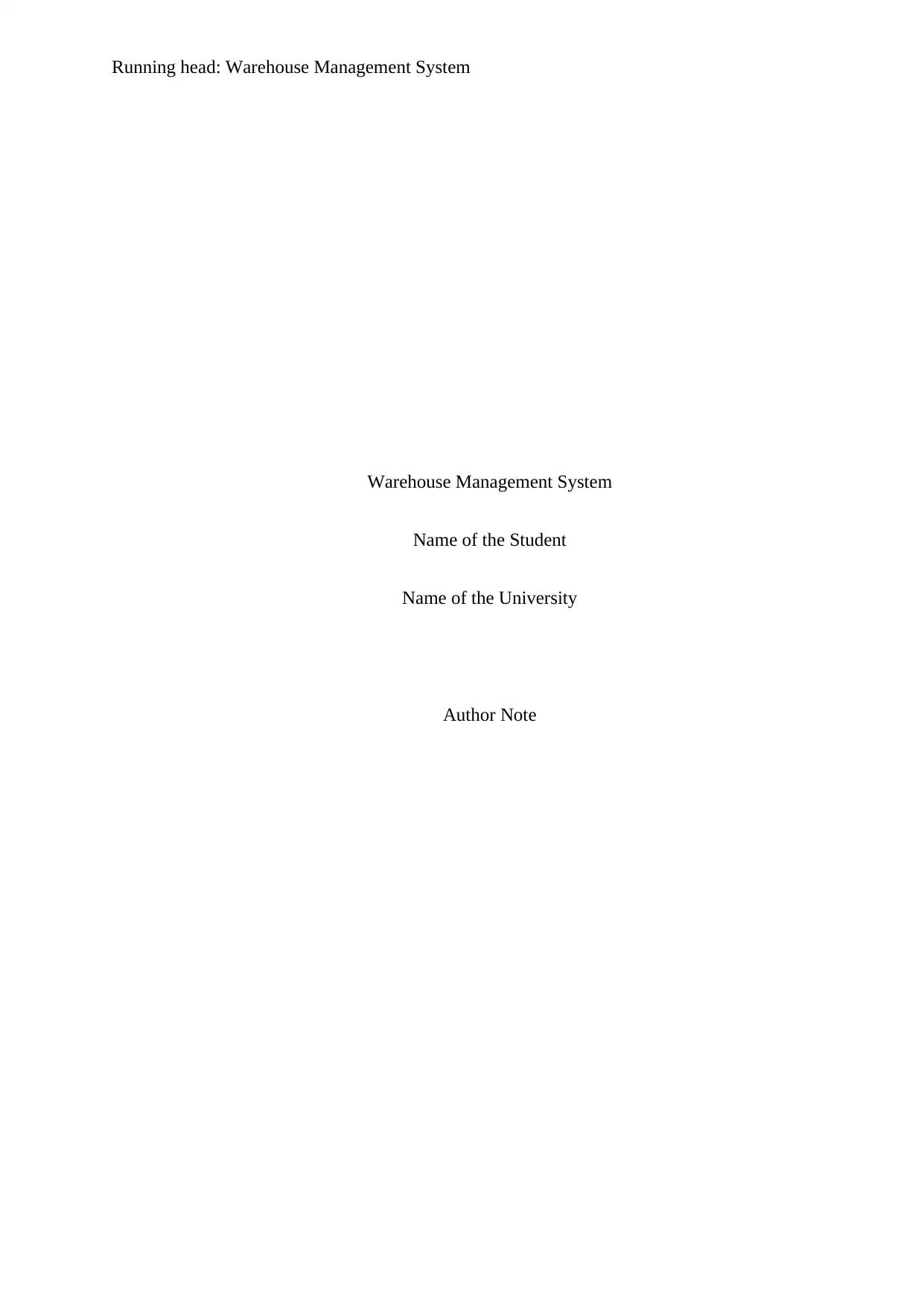
Running head: Warehouse Management System
Warehouse Management System
Name of the Student
Name of the University
Author Note
Warehouse Management System
Name of the Student
Name of the University
Author Note
Paraphrase This Document
Need a fresh take? Get an instant paraphrase of this document with our AI Paraphraser
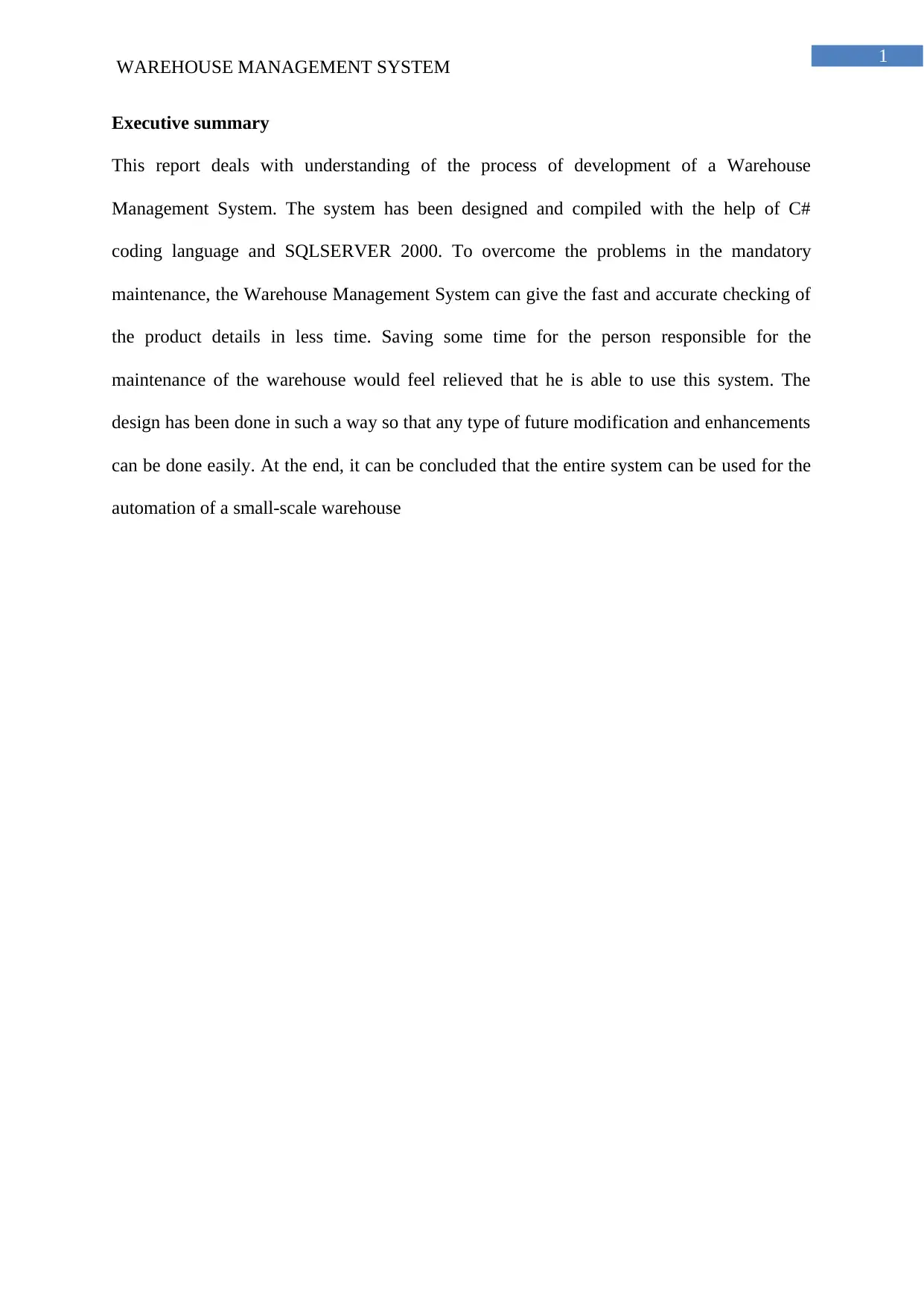
1
WAREHOUSE MANAGEMENT SYSTEM
Executive summary
This report deals with understanding of the process of development of a Warehouse
Management System. The system has been designed and compiled with the help of C#
coding language and SQLSERVER 2000. To overcome the problems in the mandatory
maintenance, the Warehouse Management System can give the fast and accurate checking of
the product details in less time. Saving some time for the person responsible for the
maintenance of the warehouse would feel relieved that he is able to use this system. The
design has been done in such a way so that any type of future modification and enhancements
can be done easily. At the end, it can be concluded that the entire system can be used for the
automation of a small-scale warehouse
WAREHOUSE MANAGEMENT SYSTEM
Executive summary
This report deals with understanding of the process of development of a Warehouse
Management System. The system has been designed and compiled with the help of C#
coding language and SQLSERVER 2000. To overcome the problems in the mandatory
maintenance, the Warehouse Management System can give the fast and accurate checking of
the product details in less time. Saving some time for the person responsible for the
maintenance of the warehouse would feel relieved that he is able to use this system. The
design has been done in such a way so that any type of future modification and enhancements
can be done easily. At the end, it can be concluded that the entire system can be used for the
automation of a small-scale warehouse
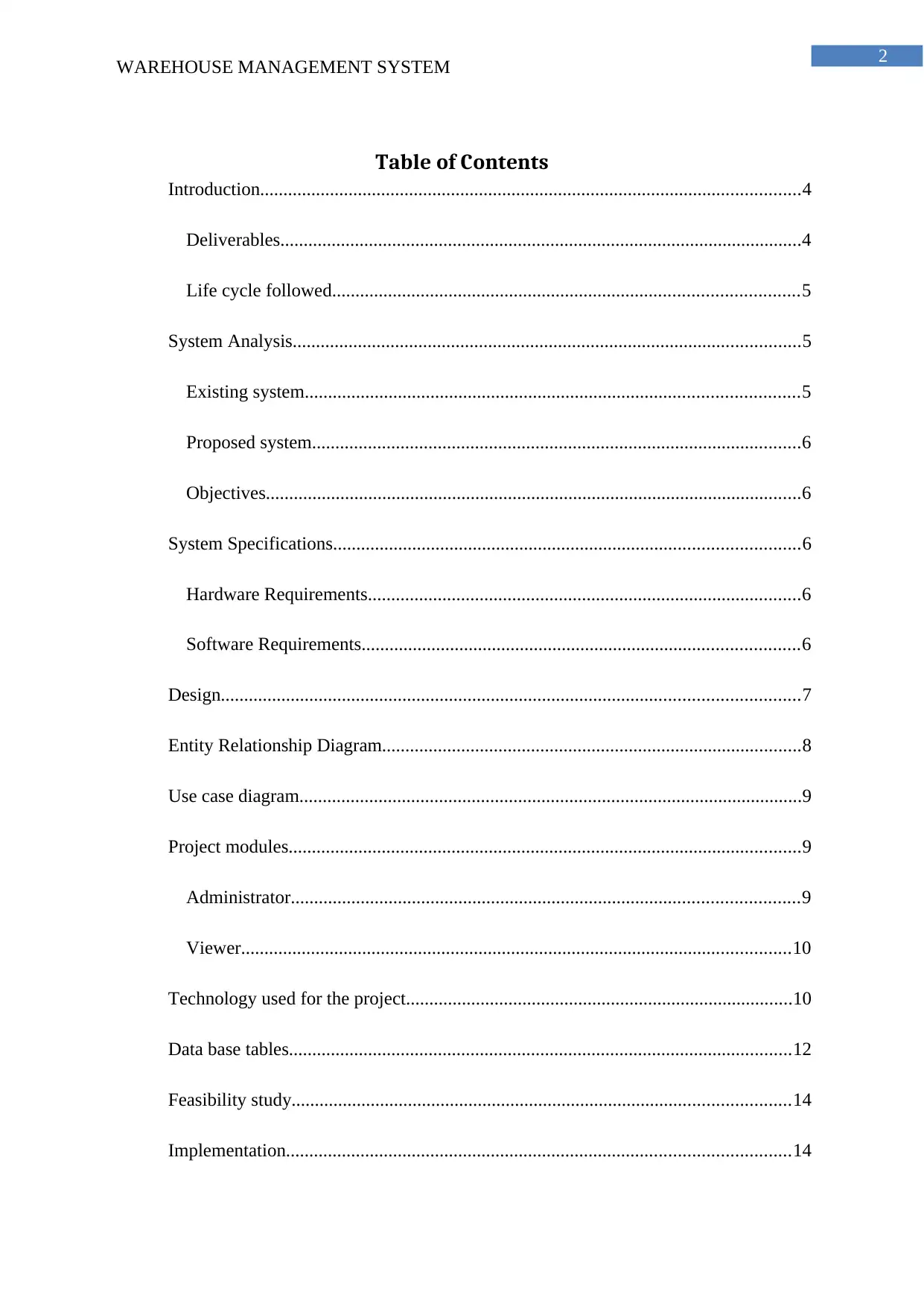
2
WAREHOUSE MANAGEMENT SYSTEM
Table of Contents
Introduction....................................................................................................................4
Deliverables................................................................................................................4
Life cycle followed....................................................................................................5
System Analysis.............................................................................................................5
Existing system..........................................................................................................5
Proposed system.........................................................................................................6
Objectives...................................................................................................................6
System Specifications....................................................................................................6
Hardware Requirements.............................................................................................6
Software Requirements..............................................................................................6
Design............................................................................................................................7
Entity Relationship Diagram..........................................................................................8
Use case diagram............................................................................................................9
Project modules..............................................................................................................9
Administrator.............................................................................................................9
Viewer......................................................................................................................10
Technology used for the project...................................................................................10
Data base tables............................................................................................................12
Feasibility study...........................................................................................................14
Implementation............................................................................................................14
WAREHOUSE MANAGEMENT SYSTEM
Table of Contents
Introduction....................................................................................................................4
Deliverables................................................................................................................4
Life cycle followed....................................................................................................5
System Analysis.............................................................................................................5
Existing system..........................................................................................................5
Proposed system.........................................................................................................6
Objectives...................................................................................................................6
System Specifications....................................................................................................6
Hardware Requirements.............................................................................................6
Software Requirements..............................................................................................6
Design............................................................................................................................7
Entity Relationship Diagram..........................................................................................8
Use case diagram............................................................................................................9
Project modules..............................................................................................................9
Administrator.............................................................................................................9
Viewer......................................................................................................................10
Technology used for the project...................................................................................10
Data base tables............................................................................................................12
Feasibility study...........................................................................................................14
Implementation............................................................................................................14
⊘ This is a preview!⊘
Do you want full access?
Subscribe today to unlock all pages.

Trusted by 1+ million students worldwide
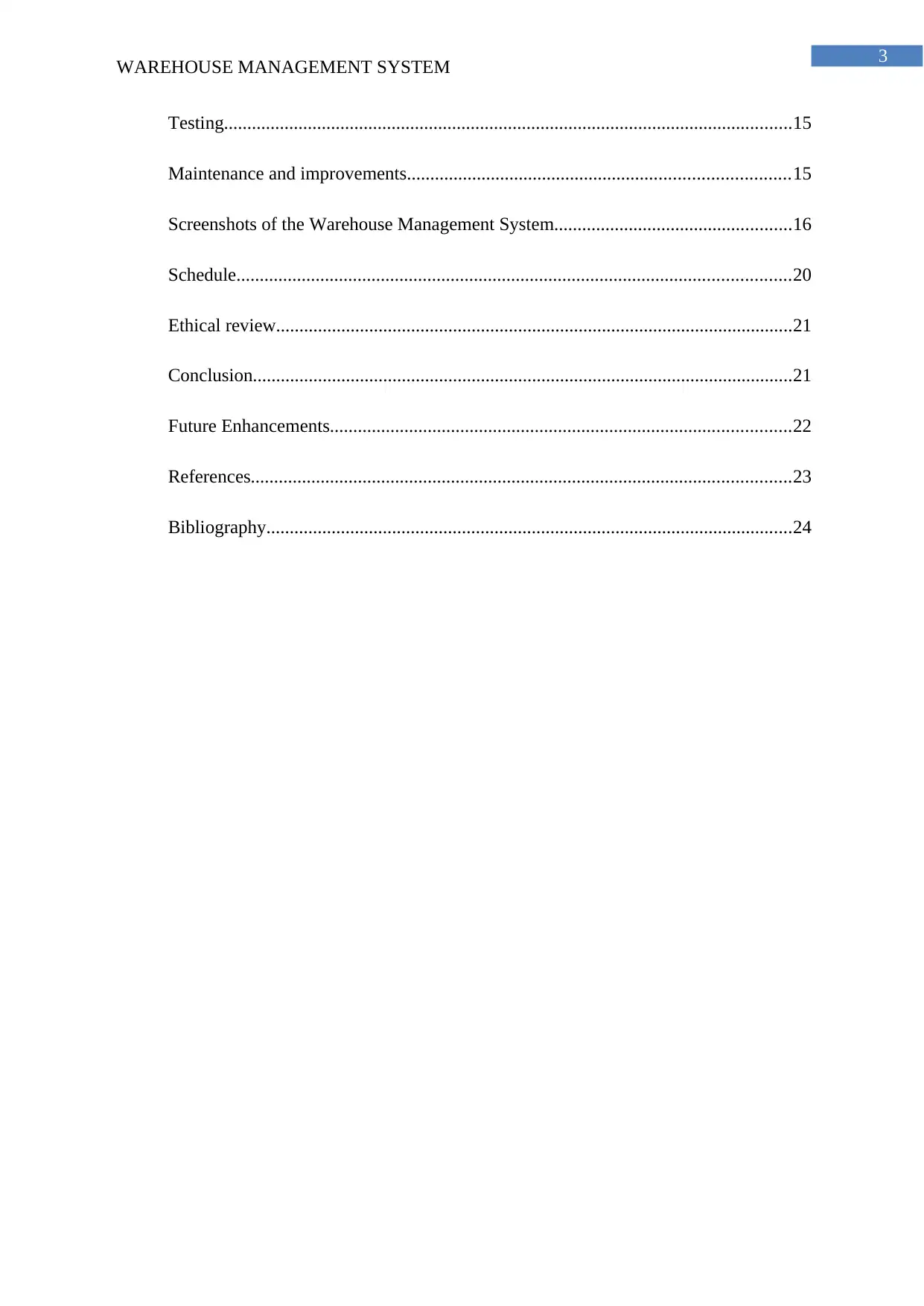
3
WAREHOUSE MANAGEMENT SYSTEM
Testing..........................................................................................................................15
Maintenance and improvements..................................................................................15
Screenshots of the Warehouse Management System...................................................16
Schedule.......................................................................................................................20
Ethical review...............................................................................................................21
Conclusion....................................................................................................................21
Future Enhancements...................................................................................................22
References....................................................................................................................23
Bibliography.................................................................................................................24
WAREHOUSE MANAGEMENT SYSTEM
Testing..........................................................................................................................15
Maintenance and improvements..................................................................................15
Screenshots of the Warehouse Management System...................................................16
Schedule.......................................................................................................................20
Ethical review...............................................................................................................21
Conclusion....................................................................................................................21
Future Enhancements...................................................................................................22
References....................................................................................................................23
Bibliography.................................................................................................................24
Paraphrase This Document
Need a fresh take? Get an instant paraphrase of this document with our AI Paraphraser
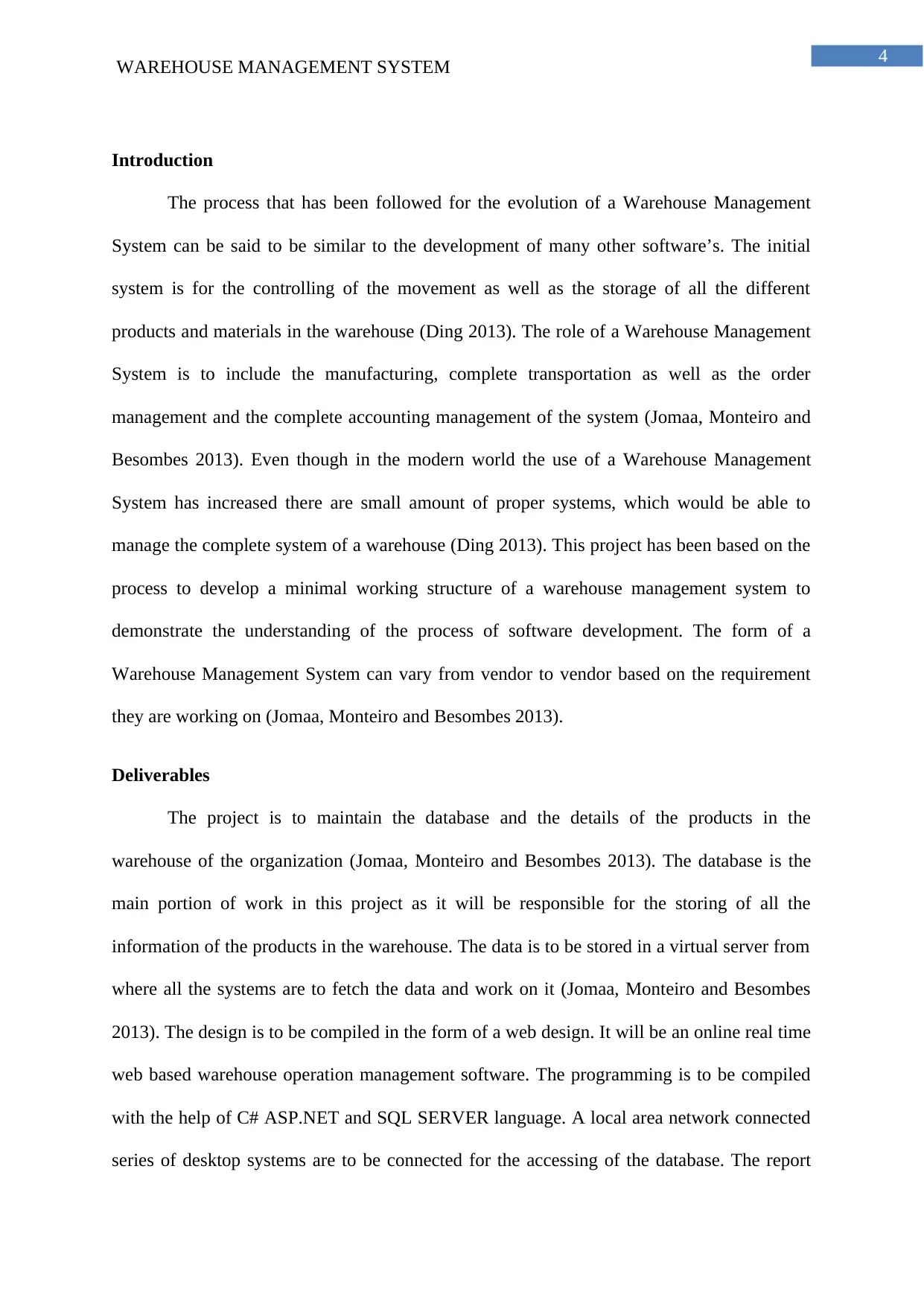
4
WAREHOUSE MANAGEMENT SYSTEM
Introduction
The process that has been followed for the evolution of a Warehouse Management
System can be said to be similar to the development of many other software’s. The initial
system is for the controlling of the movement as well as the storage of all the different
products and materials in the warehouse (Ding 2013). The role of a Warehouse Management
System is to include the manufacturing, complete transportation as well as the order
management and the complete accounting management of the system (Jomaa, Monteiro and
Besombes 2013). Even though in the modern world the use of a Warehouse Management
System has increased there are small amount of proper systems, which would be able to
manage the complete system of a warehouse (Ding 2013). This project has been based on the
process to develop a minimal working structure of a warehouse management system to
demonstrate the understanding of the process of software development. The form of a
Warehouse Management System can vary from vendor to vendor based on the requirement
they are working on (Jomaa, Monteiro and Besombes 2013).
Deliverables
The project is to maintain the database and the details of the products in the
warehouse of the organization (Jomaa, Monteiro and Besombes 2013). The database is the
main portion of work in this project as it will be responsible for the storing of all the
information of the products in the warehouse. The data is to be stored in a virtual server from
where all the systems are to fetch the data and work on it (Jomaa, Monteiro and Besombes
2013). The design is to be compiled in the form of a web design. It will be an online real time
web based warehouse operation management software. The programming is to be compiled
with the help of C# ASP.NET and SQL SERVER language. A local area network connected
series of desktop systems are to be connected for the accessing of the database. The report
WAREHOUSE MANAGEMENT SYSTEM
Introduction
The process that has been followed for the evolution of a Warehouse Management
System can be said to be similar to the development of many other software’s. The initial
system is for the controlling of the movement as well as the storage of all the different
products and materials in the warehouse (Ding 2013). The role of a Warehouse Management
System is to include the manufacturing, complete transportation as well as the order
management and the complete accounting management of the system (Jomaa, Monteiro and
Besombes 2013). Even though in the modern world the use of a Warehouse Management
System has increased there are small amount of proper systems, which would be able to
manage the complete system of a warehouse (Ding 2013). This project has been based on the
process to develop a minimal working structure of a warehouse management system to
demonstrate the understanding of the process of software development. The form of a
Warehouse Management System can vary from vendor to vendor based on the requirement
they are working on (Jomaa, Monteiro and Besombes 2013).
Deliverables
The project is to maintain the database and the details of the products in the
warehouse of the organization (Jomaa, Monteiro and Besombes 2013). The database is the
main portion of work in this project as it will be responsible for the storing of all the
information of the products in the warehouse. The data is to be stored in a virtual server from
where all the systems are to fetch the data and work on it (Jomaa, Monteiro and Besombes
2013). The design is to be compiled in the form of a web design. It will be an online real time
web based warehouse operation management software. The programming is to be compiled
with the help of C# ASP.NET and SQL SERVER language. A local area network connected
series of desktop systems are to be connected for the accessing of the database. The report
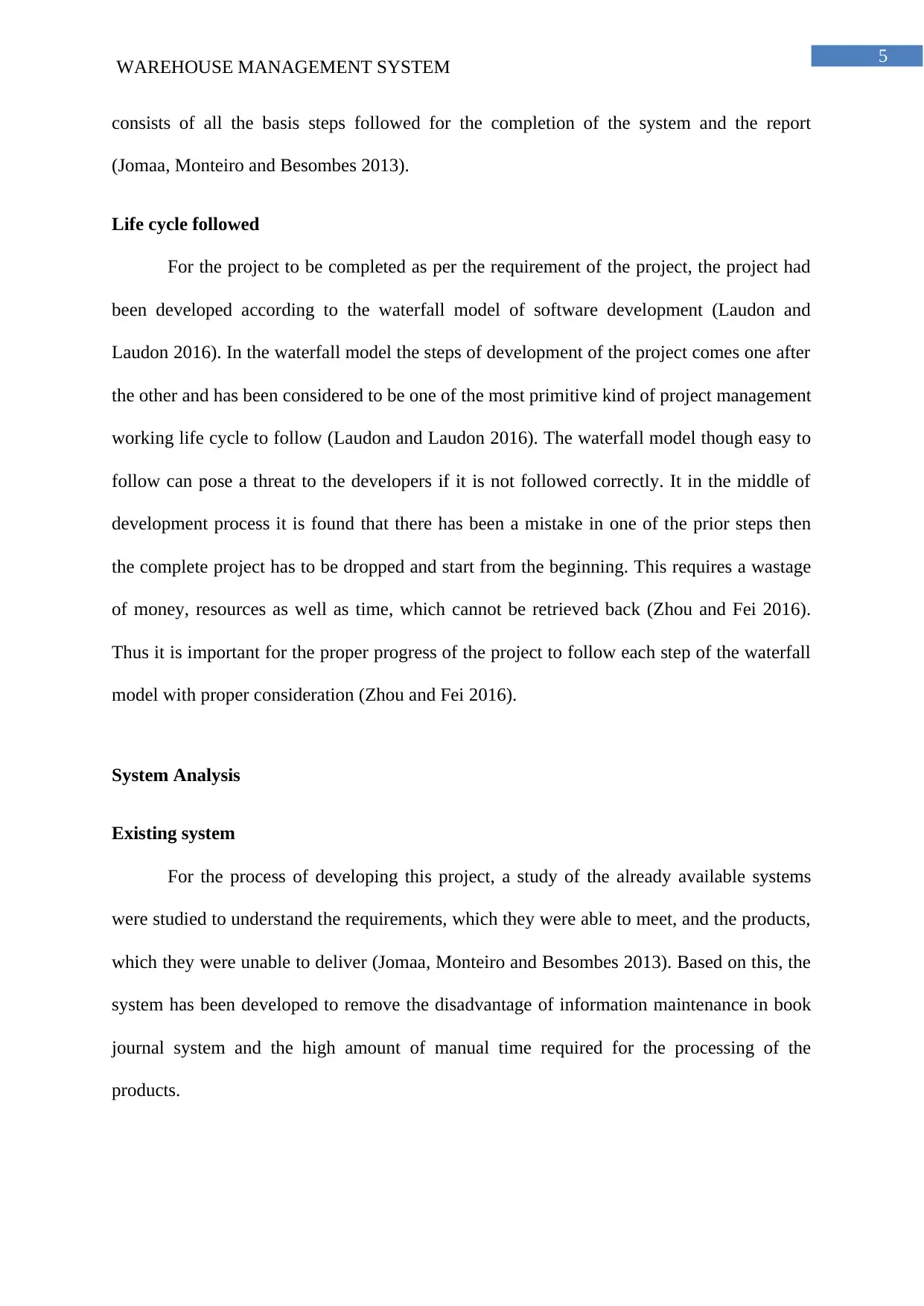
5
WAREHOUSE MANAGEMENT SYSTEM
consists of all the basis steps followed for the completion of the system and the report
(Jomaa, Monteiro and Besombes 2013).
Life cycle followed
For the project to be completed as per the requirement of the project, the project had
been developed according to the waterfall model of software development (Laudon and
Laudon 2016). In the waterfall model the steps of development of the project comes one after
the other and has been considered to be one of the most primitive kind of project management
working life cycle to follow (Laudon and Laudon 2016). The waterfall model though easy to
follow can pose a threat to the developers if it is not followed correctly. It in the middle of
development process it is found that there has been a mistake in one of the prior steps then
the complete project has to be dropped and start from the beginning. This requires a wastage
of money, resources as well as time, which cannot be retrieved back (Zhou and Fei 2016).
Thus it is important for the proper progress of the project to follow each step of the waterfall
model with proper consideration (Zhou and Fei 2016).
System Analysis
Existing system
For the process of developing this project, a study of the already available systems
were studied to understand the requirements, which they were able to meet, and the products,
which they were unable to deliver (Jomaa, Monteiro and Besombes 2013). Based on this, the
system has been developed to remove the disadvantage of information maintenance in book
journal system and the high amount of manual time required for the processing of the
products.
WAREHOUSE MANAGEMENT SYSTEM
consists of all the basis steps followed for the completion of the system and the report
(Jomaa, Monteiro and Besombes 2013).
Life cycle followed
For the project to be completed as per the requirement of the project, the project had
been developed according to the waterfall model of software development (Laudon and
Laudon 2016). In the waterfall model the steps of development of the project comes one after
the other and has been considered to be one of the most primitive kind of project management
working life cycle to follow (Laudon and Laudon 2016). The waterfall model though easy to
follow can pose a threat to the developers if it is not followed correctly. It in the middle of
development process it is found that there has been a mistake in one of the prior steps then
the complete project has to be dropped and start from the beginning. This requires a wastage
of money, resources as well as time, which cannot be retrieved back (Zhou and Fei 2016).
Thus it is important for the proper progress of the project to follow each step of the waterfall
model with proper consideration (Zhou and Fei 2016).
System Analysis
Existing system
For the process of developing this project, a study of the already available systems
were studied to understand the requirements, which they were able to meet, and the products,
which they were unable to deliver (Jomaa, Monteiro and Besombes 2013). Based on this, the
system has been developed to remove the disadvantage of information maintenance in book
journal system and the high amount of manual time required for the processing of the
products.
⊘ This is a preview!⊘
Do you want full access?
Subscribe today to unlock all pages.

Trusted by 1+ million students worldwide
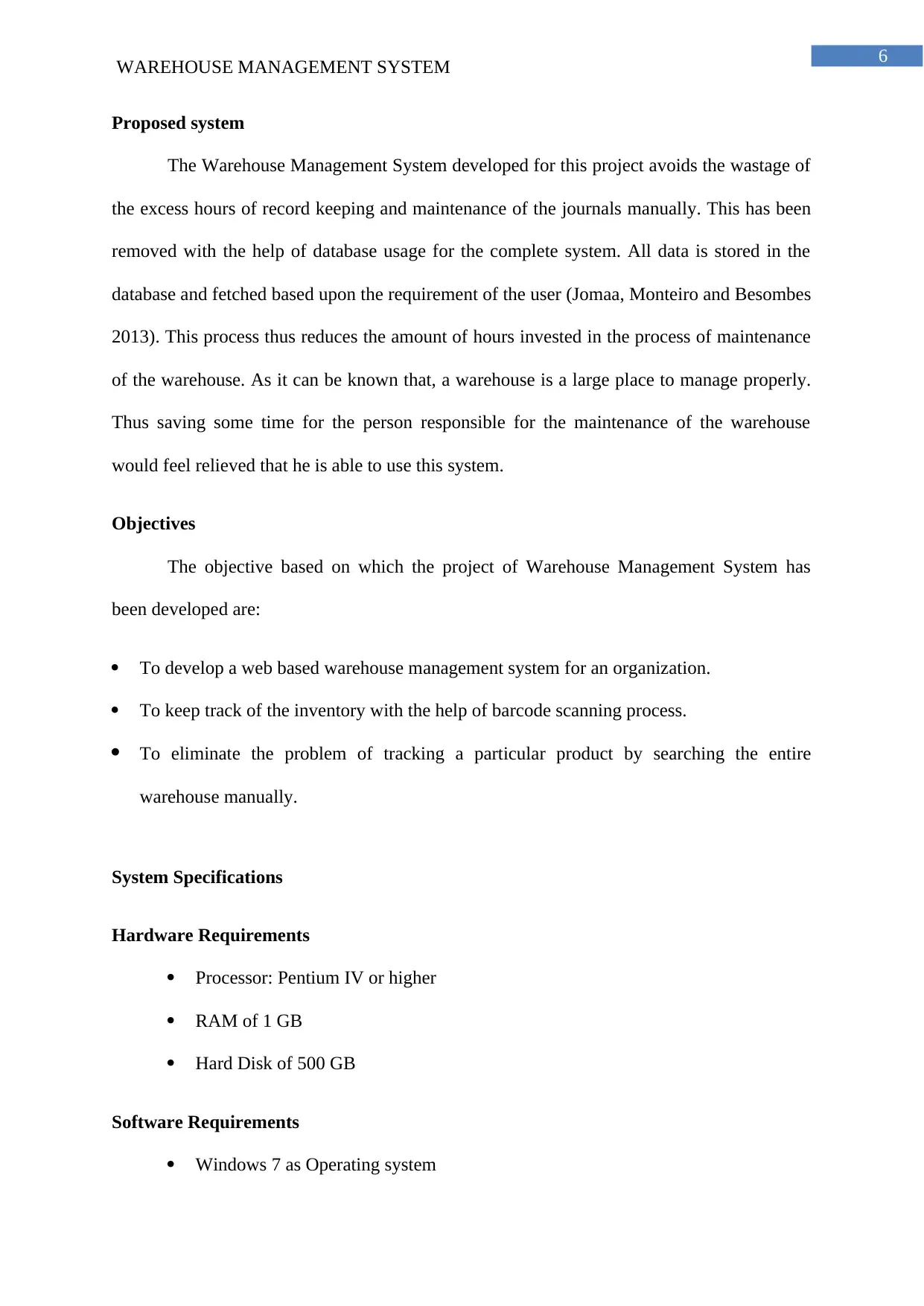
6
WAREHOUSE MANAGEMENT SYSTEM
Proposed system
The Warehouse Management System developed for this project avoids the wastage of
the excess hours of record keeping and maintenance of the journals manually. This has been
removed with the help of database usage for the complete system. All data is stored in the
database and fetched based upon the requirement of the user (Jomaa, Monteiro and Besombes
2013). This process thus reduces the amount of hours invested in the process of maintenance
of the warehouse. As it can be known that, a warehouse is a large place to manage properly.
Thus saving some time for the person responsible for the maintenance of the warehouse
would feel relieved that he is able to use this system.
Objectives
The objective based on which the project of Warehouse Management System has
been developed are:
To develop a web based warehouse management system for an organization.
To keep track of the inventory with the help of barcode scanning process.
To eliminate the problem of tracking a particular product by searching the entire
warehouse manually.
System Specifications
Hardware Requirements
Processor: Pentium IV or higher
RAM of 1 GB
Hard Disk of 500 GB
Software Requirements
Windows 7 as Operating system
WAREHOUSE MANAGEMENT SYSTEM
Proposed system
The Warehouse Management System developed for this project avoids the wastage of
the excess hours of record keeping and maintenance of the journals manually. This has been
removed with the help of database usage for the complete system. All data is stored in the
database and fetched based upon the requirement of the user (Jomaa, Monteiro and Besombes
2013). This process thus reduces the amount of hours invested in the process of maintenance
of the warehouse. As it can be known that, a warehouse is a large place to manage properly.
Thus saving some time for the person responsible for the maintenance of the warehouse
would feel relieved that he is able to use this system.
Objectives
The objective based on which the project of Warehouse Management System has
been developed are:
To develop a web based warehouse management system for an organization.
To keep track of the inventory with the help of barcode scanning process.
To eliminate the problem of tracking a particular product by searching the entire
warehouse manually.
System Specifications
Hardware Requirements
Processor: Pentium IV or higher
RAM of 1 GB
Hard Disk of 500 GB
Software Requirements
Windows 7 as Operating system
Paraphrase This Document
Need a fresh take? Get an instant paraphrase of this document with our AI Paraphraser
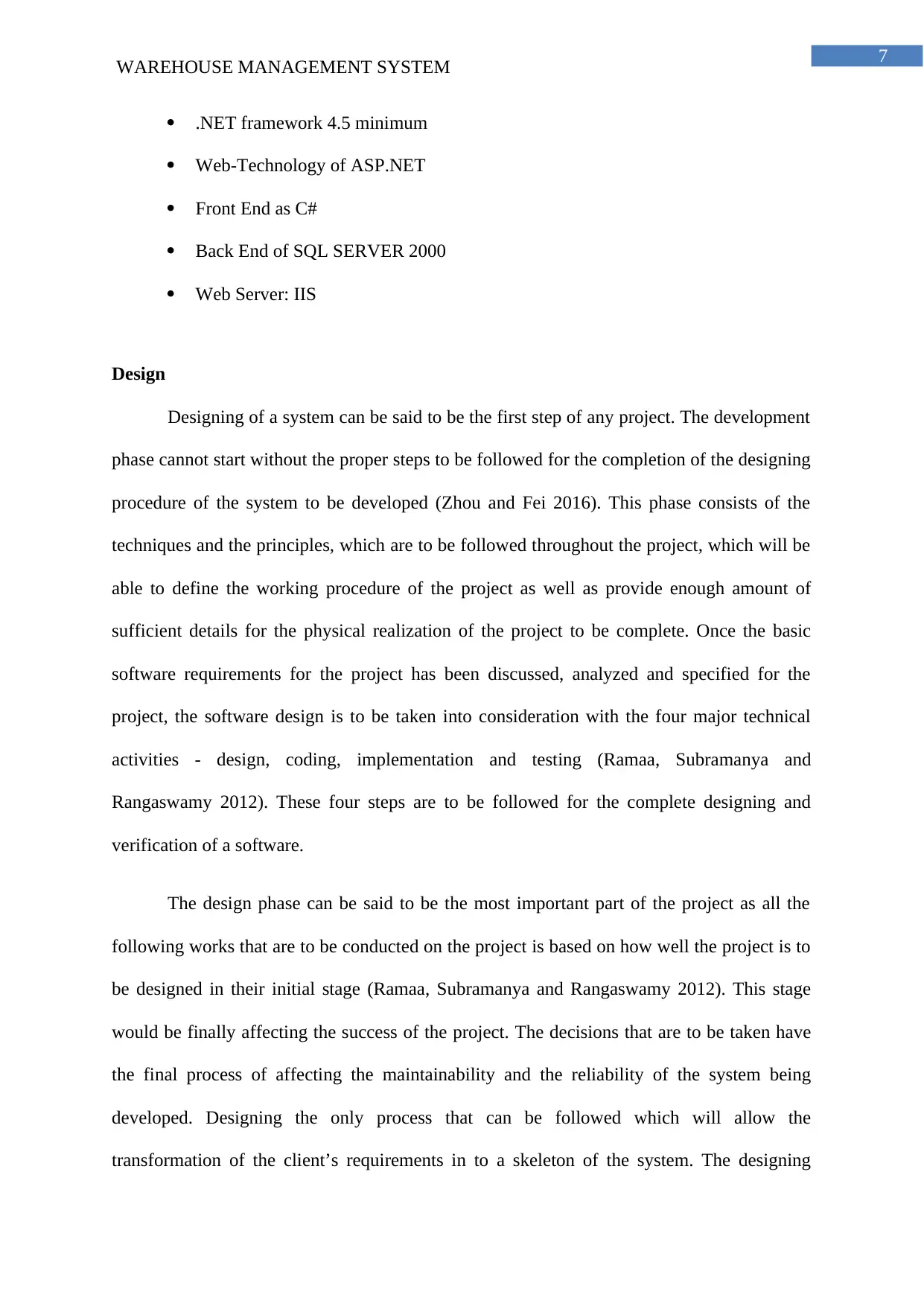
7
WAREHOUSE MANAGEMENT SYSTEM
.NET framework 4.5 minimum
Web-Technology of ASP.NET
Front End as C#
Back End of SQL SERVER 2000
Web Server: IIS
Design
Designing of a system can be said to be the first step of any project. The development
phase cannot start without the proper steps to be followed for the completion of the designing
procedure of the system to be developed (Zhou and Fei 2016). This phase consists of the
techniques and the principles, which are to be followed throughout the project, which will be
able to define the working procedure of the project as well as provide enough amount of
sufficient details for the physical realization of the project to be complete. Once the basic
software requirements for the project has been discussed, analyzed and specified for the
project, the software design is to be taken into consideration with the four major technical
activities - design, coding, implementation and testing (Ramaa, Subramanya and
Rangaswamy 2012). These four steps are to be followed for the complete designing and
verification of a software.
The design phase can be said to be the most important part of the project as all the
following works that are to be conducted on the project is based on how well the project is to
be designed in their initial stage (Ramaa, Subramanya and Rangaswamy 2012). This stage
would be finally affecting the success of the project. The decisions that are to be taken have
the final process of affecting the maintainability and the reliability of the system being
developed. Designing the only process that can be followed which will allow the
transformation of the client’s requirements in to a skeleton of the system. The designing
WAREHOUSE MANAGEMENT SYSTEM
.NET framework 4.5 minimum
Web-Technology of ASP.NET
Front End as C#
Back End of SQL SERVER 2000
Web Server: IIS
Design
Designing of a system can be said to be the first step of any project. The development
phase cannot start without the proper steps to be followed for the completion of the designing
procedure of the system to be developed (Zhou and Fei 2016). This phase consists of the
techniques and the principles, which are to be followed throughout the project, which will be
able to define the working procedure of the project as well as provide enough amount of
sufficient details for the physical realization of the project to be complete. Once the basic
software requirements for the project has been discussed, analyzed and specified for the
project, the software design is to be taken into consideration with the four major technical
activities - design, coding, implementation and testing (Ramaa, Subramanya and
Rangaswamy 2012). These four steps are to be followed for the complete designing and
verification of a software.
The design phase can be said to be the most important part of the project as all the
following works that are to be conducted on the project is based on how well the project is to
be designed in their initial stage (Ramaa, Subramanya and Rangaswamy 2012). This stage
would be finally affecting the success of the project. The decisions that are to be taken have
the final process of affecting the maintainability and the reliability of the system being
developed. Designing the only process that can be followed which will allow the
transformation of the client’s requirements in to a skeleton of the system. The designing
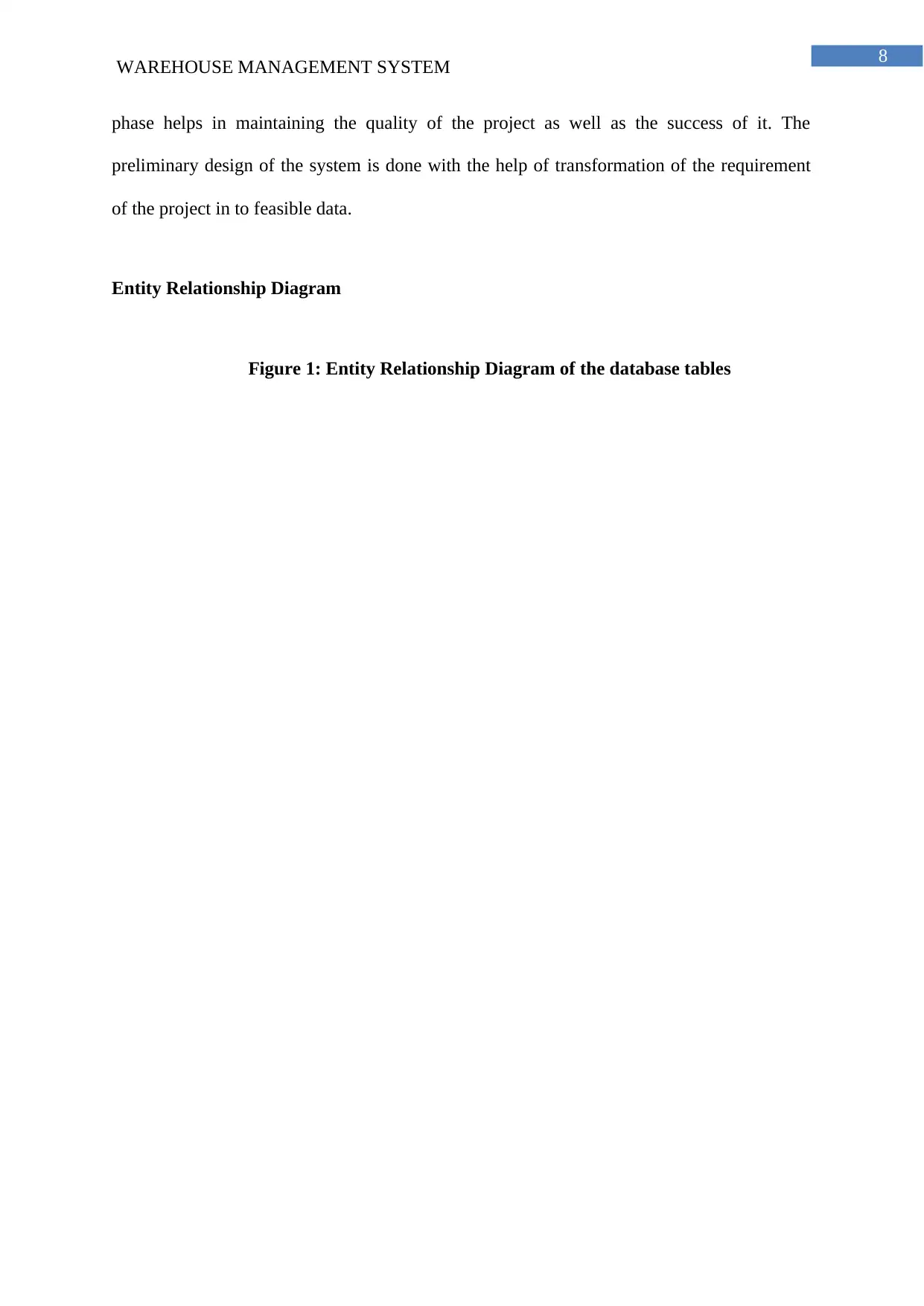
8
WAREHOUSE MANAGEMENT SYSTEM
phase helps in maintaining the quality of the project as well as the success of it. The
preliminary design of the system is done with the help of transformation of the requirement
of the project in to feasible data.
Entity Relationship Diagram
Figure 1: Entity Relationship Diagram of the database tables
WAREHOUSE MANAGEMENT SYSTEM
phase helps in maintaining the quality of the project as well as the success of it. The
preliminary design of the system is done with the help of transformation of the requirement
of the project in to feasible data.
Entity Relationship Diagram
Figure 1: Entity Relationship Diagram of the database tables
⊘ This is a preview!⊘
Do you want full access?
Subscribe today to unlock all pages.

Trusted by 1+ million students worldwide
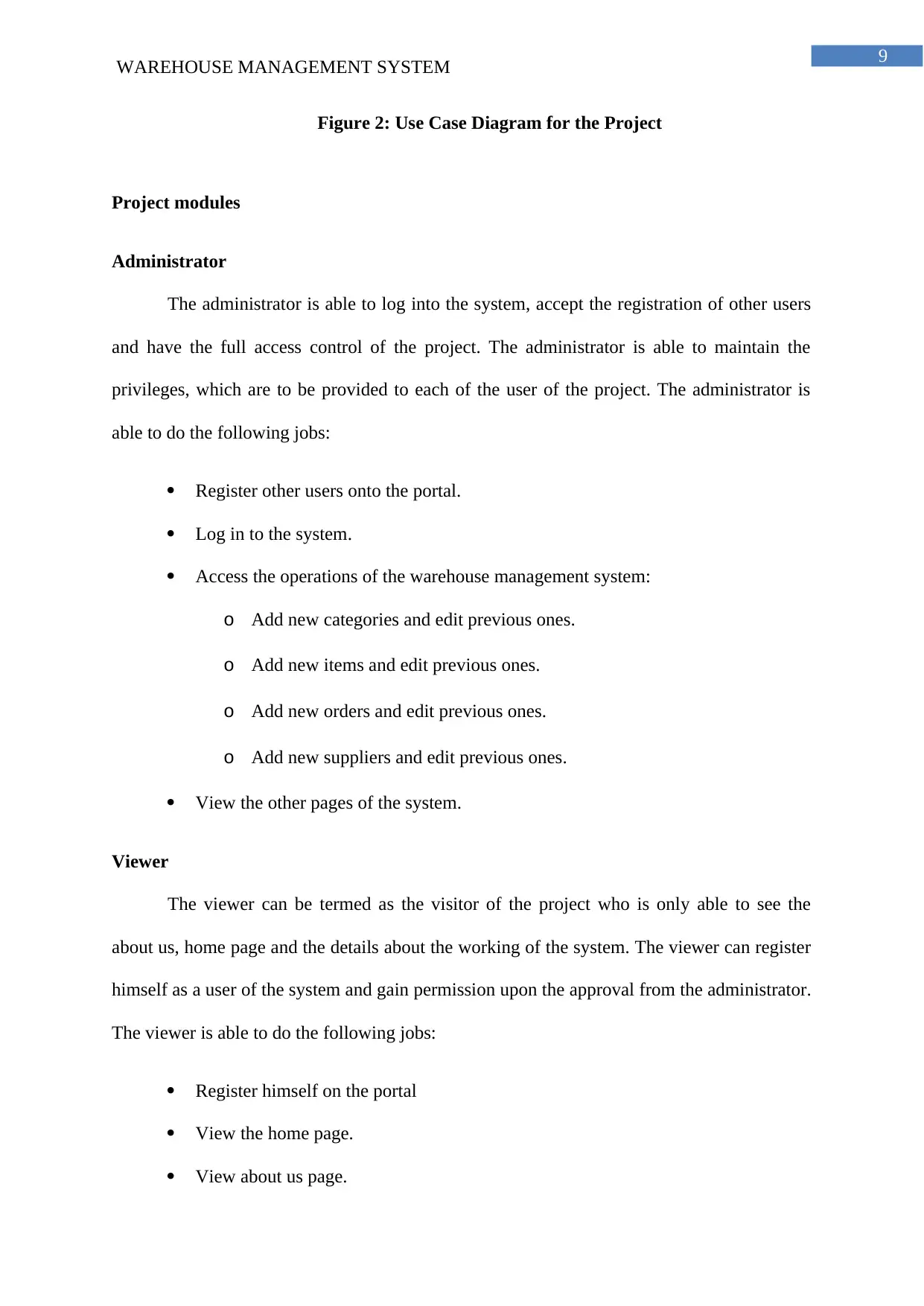
9
WAREHOUSE MANAGEMENT SYSTEM
Figure 2: Use Case Diagram for the Project
Project modules
Administrator
The administrator is able to log into the system, accept the registration of other users
and have the full access control of the project. The administrator is able to maintain the
privileges, which are to be provided to each of the user of the project. The administrator is
able to do the following jobs:
Register other users onto the portal.
Log in to the system.
Access the operations of the warehouse management system:
o Add new categories and edit previous ones.
o Add new items and edit previous ones.
o Add new orders and edit previous ones.
o Add new suppliers and edit previous ones.
View the other pages of the system.
Viewer
The viewer can be termed as the visitor of the project who is only able to see the
about us, home page and the details about the working of the system. The viewer can register
himself as a user of the system and gain permission upon the approval from the administrator.
The viewer is able to do the following jobs:
Register himself on the portal
View the home page.
View about us page.
WAREHOUSE MANAGEMENT SYSTEM
Figure 2: Use Case Diagram for the Project
Project modules
Administrator
The administrator is able to log into the system, accept the registration of other users
and have the full access control of the project. The administrator is able to maintain the
privileges, which are to be provided to each of the user of the project. The administrator is
able to do the following jobs:
Register other users onto the portal.
Log in to the system.
Access the operations of the warehouse management system:
o Add new categories and edit previous ones.
o Add new items and edit previous ones.
o Add new orders and edit previous ones.
o Add new suppliers and edit previous ones.
View the other pages of the system.
Viewer
The viewer can be termed as the visitor of the project who is only able to see the
about us, home page and the details about the working of the system. The viewer can register
himself as a user of the system and gain permission upon the approval from the administrator.
The viewer is able to do the following jobs:
Register himself on the portal
View the home page.
View about us page.
Paraphrase This Document
Need a fresh take? Get an instant paraphrase of this document with our AI Paraphraser
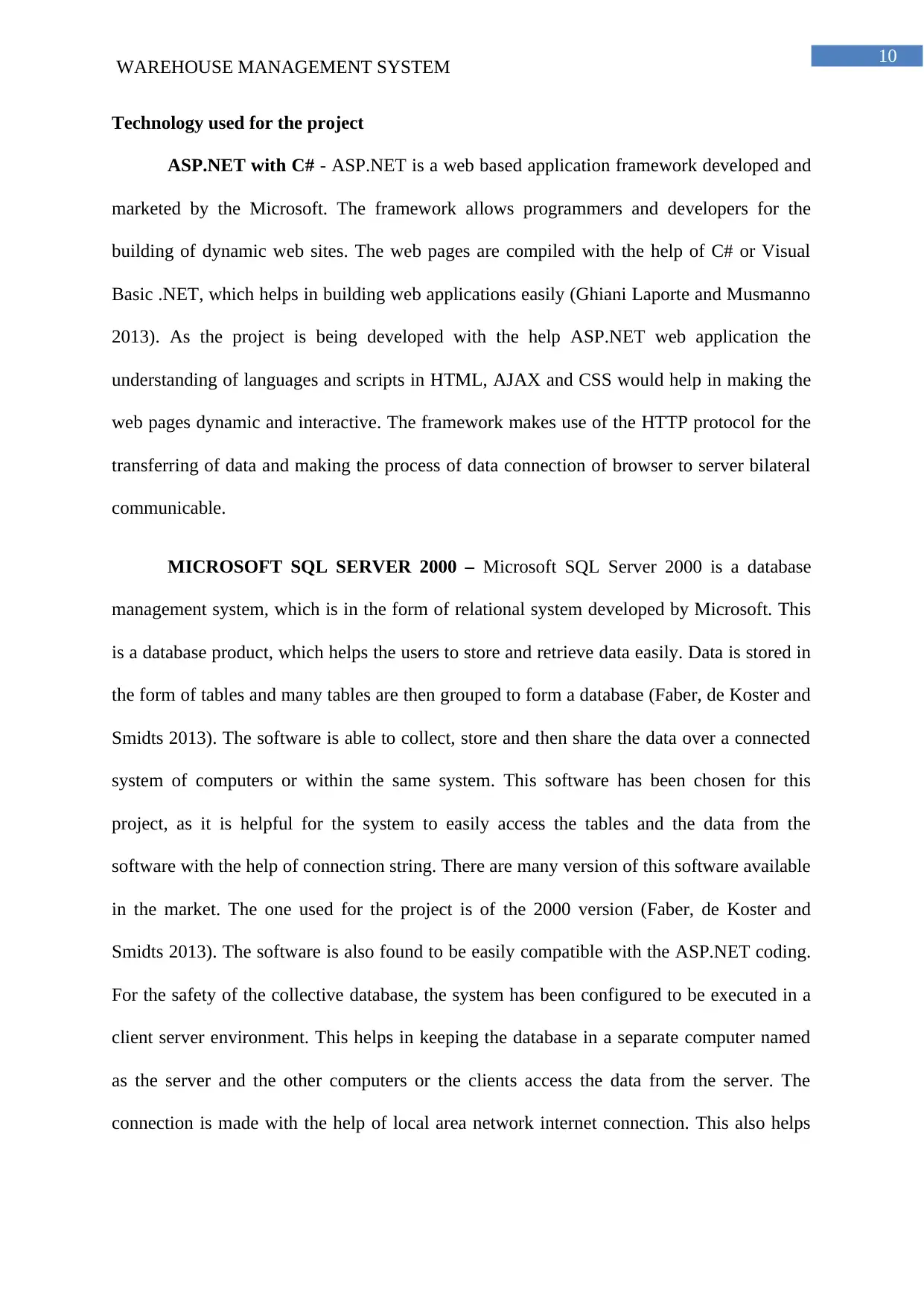
10
WAREHOUSE MANAGEMENT SYSTEM
Technology used for the project
ASP.NET with C# - ASP.NET is a web based application framework developed and
marketed by the Microsoft. The framework allows programmers and developers for the
building of dynamic web sites. The web pages are compiled with the help of C# or Visual
Basic .NET, which helps in building web applications easily (Ghiani Laporte and Musmanno
2013). As the project is being developed with the help ASP.NET web application the
understanding of languages and scripts in HTML, AJAX and CSS would help in making the
web pages dynamic and interactive. The framework makes use of the HTTP protocol for the
transferring of data and making the process of data connection of browser to server bilateral
communicable.
MICROSOFT SQL SERVER 2000 – Microsoft SQL Server 2000 is a database
management system, which is in the form of relational system developed by Microsoft. This
is a database product, which helps the users to store and retrieve data easily. Data is stored in
the form of tables and many tables are then grouped to form a database (Faber, de Koster and
Smidts 2013). The software is able to collect, store and then share the data over a connected
system of computers or within the same system. This software has been chosen for this
project, as it is helpful for the system to easily access the tables and the data from the
software with the help of connection string. There are many version of this software available
in the market. The one used for the project is of the 2000 version (Faber, de Koster and
Smidts 2013). The software is also found to be easily compatible with the ASP.NET coding.
For the safety of the collective database, the system has been configured to be executed in a
client server environment. This helps in keeping the database in a separate computer named
as the server and the other computers or the clients access the data from the server. The
connection is made with the help of local area network internet connection. This also helps
WAREHOUSE MANAGEMENT SYSTEM
Technology used for the project
ASP.NET with C# - ASP.NET is a web based application framework developed and
marketed by the Microsoft. The framework allows programmers and developers for the
building of dynamic web sites. The web pages are compiled with the help of C# or Visual
Basic .NET, which helps in building web applications easily (Ghiani Laporte and Musmanno
2013). As the project is being developed with the help ASP.NET web application the
understanding of languages and scripts in HTML, AJAX and CSS would help in making the
web pages dynamic and interactive. The framework makes use of the HTTP protocol for the
transferring of data and making the process of data connection of browser to server bilateral
communicable.
MICROSOFT SQL SERVER 2000 – Microsoft SQL Server 2000 is a database
management system, which is in the form of relational system developed by Microsoft. This
is a database product, which helps the users to store and retrieve data easily. Data is stored in
the form of tables and many tables are then grouped to form a database (Faber, de Koster and
Smidts 2013). The software is able to collect, store and then share the data over a connected
system of computers or within the same system. This software has been chosen for this
project, as it is helpful for the system to easily access the tables and the data from the
software with the help of connection string. There are many version of this software available
in the market. The one used for the project is of the 2000 version (Faber, de Koster and
Smidts 2013). The software is also found to be easily compatible with the ASP.NET coding.
For the safety of the collective database, the system has been configured to be executed in a
client server environment. This helps in keeping the database in a separate computer named
as the server and the other computers or the clients access the data from the server. The
connection is made with the help of local area network internet connection. This also helps
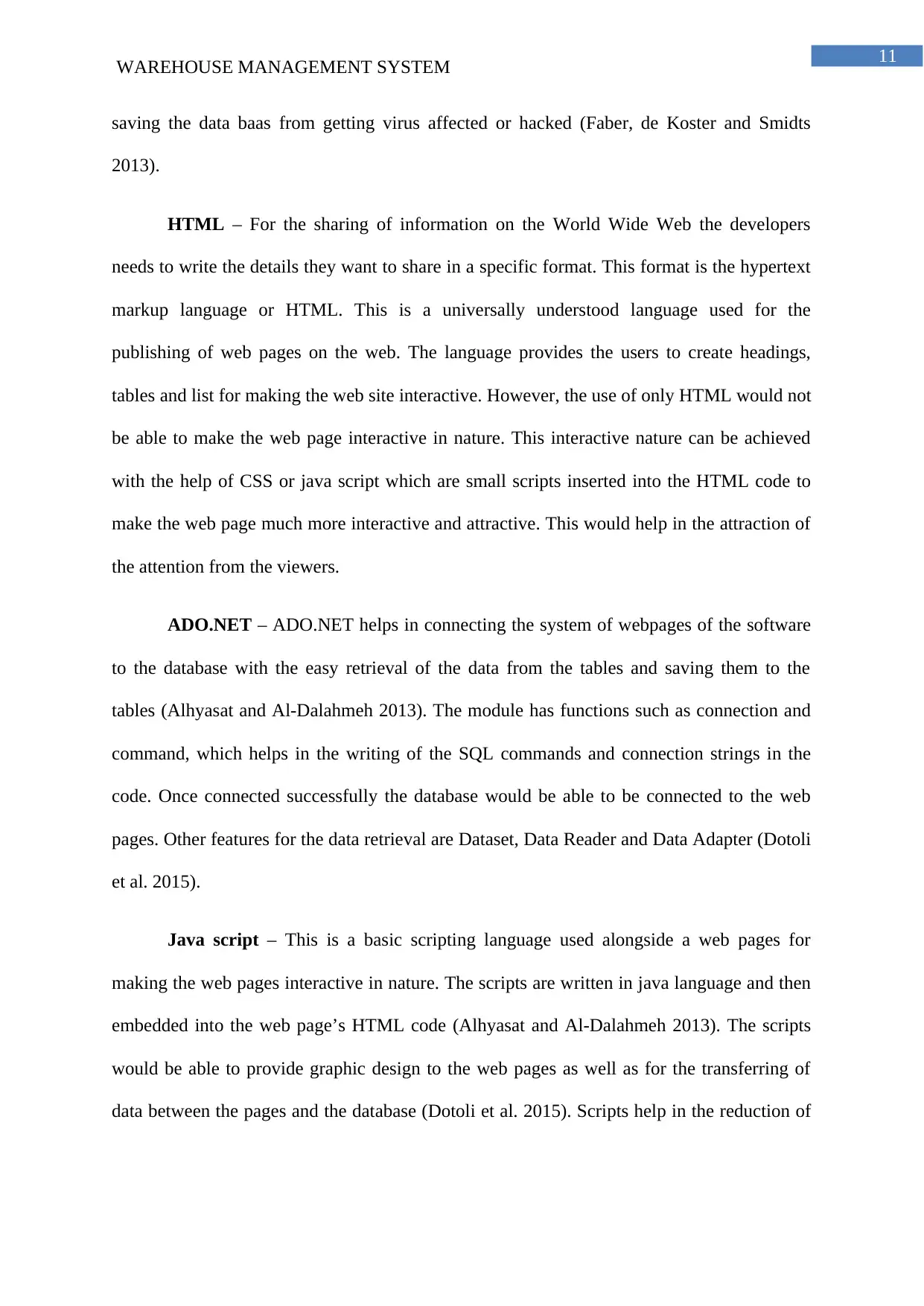
11
WAREHOUSE MANAGEMENT SYSTEM
saving the data baas from getting virus affected or hacked (Faber, de Koster and Smidts
2013).
HTML – For the sharing of information on the World Wide Web the developers
needs to write the details they want to share in a specific format. This format is the hypertext
markup language or HTML. This is a universally understood language used for the
publishing of web pages on the web. The language provides the users to create headings,
tables and list for making the web site interactive. However, the use of only HTML would not
be able to make the web page interactive in nature. This interactive nature can be achieved
with the help of CSS or java script which are small scripts inserted into the HTML code to
make the web page much more interactive and attractive. This would help in the attraction of
the attention from the viewers.
ADO.NET – ADO.NET helps in connecting the system of webpages of the software
to the database with the easy retrieval of the data from the tables and saving them to the
tables (Alhyasat and Al-Dalahmeh 2013). The module has functions such as connection and
command, which helps in the writing of the SQL commands and connection strings in the
code. Once connected successfully the database would be able to be connected to the web
pages. Other features for the data retrieval are Dataset, Data Reader and Data Adapter (Dotoli
et al. 2015).
Java script – This is a basic scripting language used alongside a web pages for
making the web pages interactive in nature. The scripts are written in java language and then
embedded into the web page’s HTML code (Alhyasat and Al-Dalahmeh 2013). The scripts
would be able to provide graphic design to the web pages as well as for the transferring of
data between the pages and the database (Dotoli et al. 2015). Scripts help in the reduction of
WAREHOUSE MANAGEMENT SYSTEM
saving the data baas from getting virus affected or hacked (Faber, de Koster and Smidts
2013).
HTML – For the sharing of information on the World Wide Web the developers
needs to write the details they want to share in a specific format. This format is the hypertext
markup language or HTML. This is a universally understood language used for the
publishing of web pages on the web. The language provides the users to create headings,
tables and list for making the web site interactive. However, the use of only HTML would not
be able to make the web page interactive in nature. This interactive nature can be achieved
with the help of CSS or java script which are small scripts inserted into the HTML code to
make the web page much more interactive and attractive. This would help in the attraction of
the attention from the viewers.
ADO.NET – ADO.NET helps in connecting the system of webpages of the software
to the database with the easy retrieval of the data from the tables and saving them to the
tables (Alhyasat and Al-Dalahmeh 2013). The module has functions such as connection and
command, which helps in the writing of the SQL commands and connection strings in the
code. Once connected successfully the database would be able to be connected to the web
pages. Other features for the data retrieval are Dataset, Data Reader and Data Adapter (Dotoli
et al. 2015).
Java script – This is a basic scripting language used alongside a web pages for
making the web pages interactive in nature. The scripts are written in java language and then
embedded into the web page’s HTML code (Alhyasat and Al-Dalahmeh 2013). The scripts
would be able to provide graphic design to the web pages as well as for the transferring of
data between the pages and the database (Dotoli et al. 2015). Scripts help in the reduction of
⊘ This is a preview!⊘
Do you want full access?
Subscribe today to unlock all pages.

Trusted by 1+ million students worldwide
1 out of 26
Related Documents
Your All-in-One AI-Powered Toolkit for Academic Success.
+13062052269
info@desklib.com
Available 24*7 on WhatsApp / Email
![[object Object]](/_next/static/media/star-bottom.7253800d.svg)
Unlock your academic potential
Copyright © 2020–2025 A2Z Services. All Rights Reserved. Developed and managed by ZUCOL.




